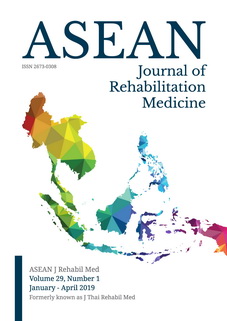A Retrospective Study of Ultrasound Guided Capsular Hydrodilatation with a Mixture of Normal Saline, Lidocaine and Triamcinolone Injection in Patient with Adhesive Capsulitis
การศึกษาย้อนหลังการใช้อัลตราซาวนด์ช่วยนำการฉีดน้ำเกลือ ยาชา และยาสเตียรอยด์เพื่อขยายเยื่อหุ้มข้อไหล่ในผู้ป่วยโรคไหล่ติด
Keywords:
Keywords: adhesive capsulitis, ultrasonography, capsular hydrodilatation with corticosteriod injectionAbstract
Objectives: To report change in pain of shoulder joint after ultrasound guided capsular hydrodilatation with corticosteriod injection.
Study design: Retrospective study
Setting: Chophraya Yommarat Hospital, Suphanburi
Subjects: Patients with a diagnosis of adhesive capsulitis who had pre-treatment subjective numeric pain rating scale (NPRS) at least 4 after physical therapy for at least a month; treated with an ultrasound guided capsular hydrodilatation with a mixture of 4 ml 10mg/mL triamcinolone acetonide, 6ml of 1% lidocaine, and 10 mL of normal saline by a physiatrist; and having at least 3 follow-up re-assessments, were recruited into the study.
Methods: Twenty patients’ medical records were retrospectively reviewed. Outcome measurement was the treated shoulder NPRS at weeks 1, 5, and 12-14 post-treatment; and the data were compared and analyzed by using the linear mixed model.
Results: There were statistically significant improvements in median (minimum, maximum) NPRS (p<0.001) from baseline 6 (4, 7) to 2 (0, 5) at week 1, 1 (0, 5) at week 5 and 0.5 (0, 3) at week 12-14 post treatment. No side effects were found.
Conclusion: This retrospective study demonstrated that the ultrasound guided capsular hydrodilatation with a mixture of normal saline, lidocaine and triamcinolone acetonide, injection done by a trained physiatrist could reduce shoulder pain in patients with adhesive capsulitis.
Keywords: adhesive capsulitis, ultrasonography, capsular hydrodilatation with corticosteriod injection, pain
References
2. Tamai K, Akutsu M, Yano Y. Primary frozen shoulder: brief review of pathology and imaging abnormalities. J Orthop Sci. 2014;19:1-5.
3. Lee DH, Yoon SH, Lee MY, Kwack KS, Rah UW. Capsule-preserving hydrodilatation with corticosteroid versus corticosteroid injection alone in refractory adhesive capsulitis of shoulder: a randomized controlled trial. Arch Phys Med Rehabil. 2017; 98:815-21.
4. Shaffer B, Tibone JE, Kerlan RK. Frozen Shoulder: A long-term follow -up. J Bone Joint Surg Am. 1992;74:738-46.
5. Le HV, Lee SJ, Nazarian A, Rodriguez EK. Adhesive capsulitis of the shoulder: review of pathophysiology and current clinical treatments. Shoulder Elbow. 2017;9:75–84.
6. Griesser M, Harris J, Campbell J, Jones G. Adhesive capsulitis of the shoulder: a systematic review of the effectiveness of intra-articular corticosteroid injections. J Bone Joint Surg Am. 2011; 93:1727-1733.
7. Xiao RC, Walley KC, DeAngelis JP, Ramappa AJ. Corticosteroid Injections for Adhesive Capsulitis: A Review. Clin J Sport Med. 2017;27:308–20.
8. Wu WT, Chang KV, Han DS, Chang CH, Yang FS, Lin CP. Effectiveness of glenohumeral joint dilatation for treatment of frozen shoulder: a systematic review and meta-analysis of randomized controlled trials. Sci Rep. 2017;7:10507.
9. Sinha R, Patel P, Rose N, Tuckett J, Banerjee AN, Williams J, et al. Analysis of hydrodilatation as part of a combined service for stiff shoulder. Shoulder Elbow. 2017;9:169–77.
10. Quraishi NA, Johnston P, Bayer J, Crowe M, Chakrabarti AJ. Thawing the frozen shoulder: a randomized trial comparing manipulation under anaesthesia with hydrodilatation. J Bone Joint Surg Br. 2007;89:1197–200.
11. Kim K, Lee KJ, Kim HC, Lee KJ, Kim DK, Chung SG. Capsule preservation improves short-term outcome of hydraulic distension in painful stiff shoulder. J Orthop Res. 2011;29:1688–94.
15. Yoon JP, Chung SW, Kim JE, Kim SK, Lee HJ, Jeong WJ, et al. Intra-articular injection, subacromial injection, and hydrodilatation for primary frozen shoulder: a randomized clinical trial. J Shoulder Elbow Surg. 2016;25:376-83.
16. Ibrahim T, Rahbi H, Beiri A, Jeyapalan K, Taylor GJ. Adhesive capsulitis of the shoulder: the rate of manipulation following distension arthrogram. Rheumatol Int. 2006;27:7-9.
17. Yoon JP, Chung SW, Kim JE, Kim HS, Lee HJ, Jeong WJ, et al. Intra-articular injection, subacromial injection, and hydrodilatation for primary frozen shoulder: a randomized clinical trial. J Shoulder Elbow Surg. 2016;25:376-83.
18. Lee KJ, Lee HD, Chung SG. Real-time pressure monitoring of intraarticular hydraulic distension for painful stiff shoulders. J Orthop Res. 2008;26:965-70.
19. Kim K, Lee KJ, Kim HC, Lee KJ, Kim DK, Chung SG. Capsule preservation improves short-term outcome of hydraulic distension in painful stiff shoulder. J Orthop Res. 2011;29:1688-94.
20. Robinson PM, Norris J, Roberts CP. Randomized controlled trial of supervised physiotherapy versus a home exercise program after hydrodilatation for the management of primary frozen shoulder. J Shoulder Elbow Surg. 2017;26:757-65.
21. Lin MT, Hsiao MY, Tu YK, Wang TG.Comparative Efficacy of Intra-Articular Steroid Injection and Distension in Patients With Frozen Shoulder: A Systematic Review and Network Meta-Analysis. Arch Phys Med Rehabil. 2018;99:1383-94.






